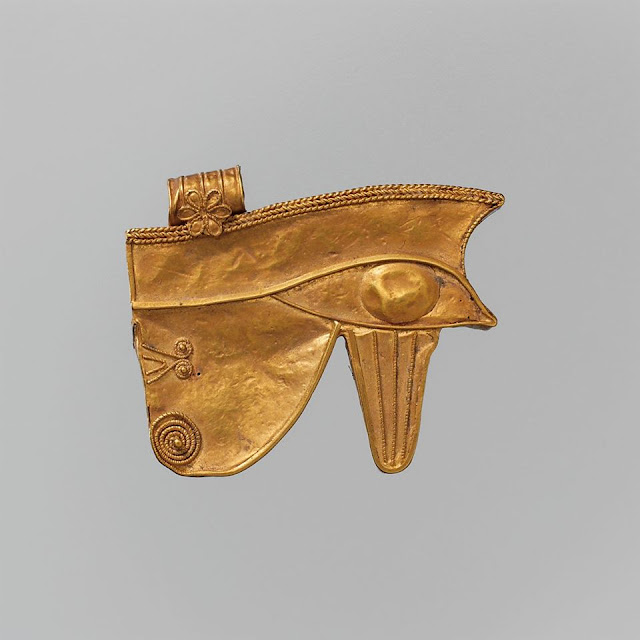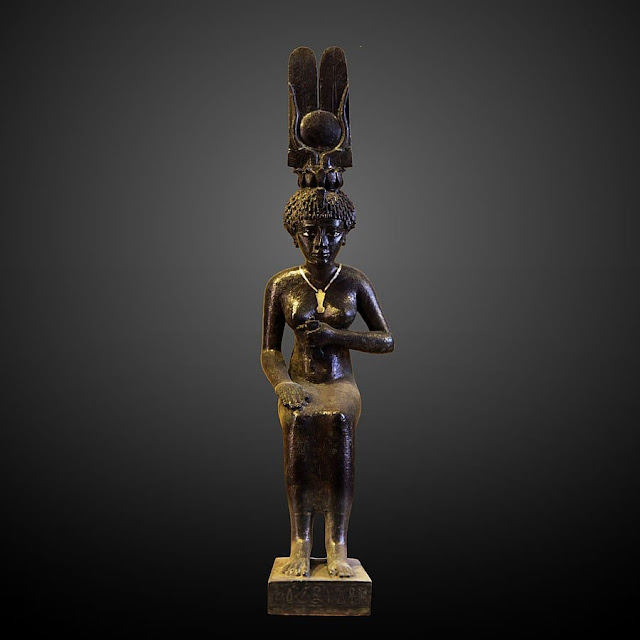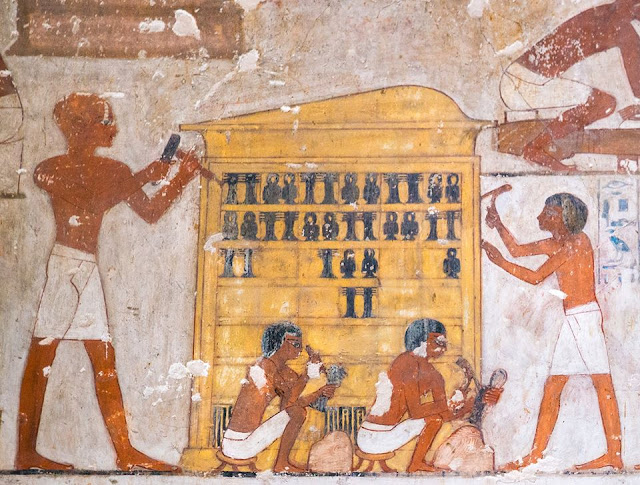Egypt came first, then history and civilization came. Egypt has one of the world's seven wonders of the pyramids. The Virgin Mary came to protect herself and her son. Egypt is the safest destination for tourism. My goal is to help foreigners learn my country’s history, come to Egypt, whatever your budget, and I will be your guide at no additional cost to you. booking with us. The goal is to service booking tours to Egypt. the best Nile cruise in Egypt. https://kingofegypttours.com
Wednesday, 15 April 2020
View from Queen Nefertari Cemetery, Valley of the Queens.
View from Queen Nefertari Cemetery, Valley of the Queens, from the family 19, around 1550 BC
On the left, Osiris stands in his body, known as the body mummified with white linen scrolls, in which he holds his king's wands, and the tapes of Isis and Nephthys hang over his body (the presence of these tapes on the body of Osir aims to protect him), and on both sides are pictures of the Egyptian artist, the goddess "Nate" and the goddess Scorpion "Selkit" ( Their presence together in any scene symbolizing the North-South binomial, and also for the inhalation and exhalation dichotomy or contraction)
On the portals of the side rooms, pictures of the Egyptian artist, Isis and Nephthys, to complete this quadrant of protection, which is the quadruple four goddesses who protect the king's coffin, as well as canopic vessels that contain his bowels.
To the right of the opening of the door is a scene depicting the ancient Egyptian artist, "Ra Hor my sister".
(Ra Horus the traveler between the two horizons) Sitting on his throne and behind him is Hathor, the goddess of the West, in the form of the nitrate, "Amnet." And they are provided with bread and water (the energy) that strengthens them, so that they can pass the trial that prepares them for rebirth in the realm of spirit and eternity in the fields of eternity (Ayuru).
The ancient Egyptians believed that "Amant" lived inside a tree on the edge of the desert and overlooked the gate of the other world. It was depicted in the form of a woman bearing the sign of the West mark above her head, which is a semicircle from which a long stick and another smaller than her, and above the semicircle, stand either as a feather or falcon, and when "Amnet" was appearing on top of the coffins, which the ancient Egyptian artist depicted with two wings spread over the dead body of the dead.
"Amnet" was closely related to Hathor and Isis in their role in the other world, so it is possible to see her as not independent of them, but an alternative figure for them.
To the left of the section are pictures of "Khubari" with a human body and the head of a scarab (and my news is the symbol of the morning sun, and also the symbol of resurrection, transformation, becoming, and the new birth)
The door leads to an interior room in which part of a mural depicting "Uzair" sitting on his throne and in front of him, shows the four sons of Horus who are in charge of protecting canopic vessels and the entrails inside them.
And behind the wall on which the scene of "Ra Hor Hur my sister" appears and the western goddess of Hathor appears from the inside. There is a rare scene from the book "The Supplications of Ra", which is one of the rarest scenes that mixed between each of Osir and Ra in one entity, which is "Ra - Osir".
It is a special part of the union of "Ra" and "Osir" and is concerned in particular with the effect of "Ra" on the lower world (the kingdom of Ozir) and we find from the names of "Ra" that were mentioned: (Ra who is in the lower world, Ra who is in the cave, Ra is the master in his cave Ra who renews the energy of the earth, Ra who is in the West)
This blue faience ankh (the hieroglyphic sign for “life”)
This blue faience ankh (the hieroglyphic sign for “life”) was found in the tomb of Thutmose IV in the Valley of the Kings (KV 43). A bright blue glazed surface is detailed with a deep violet manganese pigment. The arms of the ankh are detailed to resemble rope. The base carries a long-stemmed lotus flower, above which (at roughly the center of the piece) is the cartouche of the Thutmose IV.
Date: New Kingdom, Dynasty 18, reign of Thutmose IV
1400–1390 B.C.
MFA Boston
paradise in the eyes of the ancient Egyptian was a workhouse but with eternity.
One of those who worked in the tombs of the Valley of the Kings and as a kind of pride in participating in this sacred work decided to keep his ballet with the colours he had in his cemetery so that when he resurrected in the other world he would review his art and his work because paradise in the eyes of the ancient Egyptian was a workhouse but with eternity
The first ruler in the history of ancient Egypt.
The ruler is now on display in the Louvre Museum
The modern state dates back to the 18th Dynasty
It belongs to a senior employee named Maya who was the treasurer
During the reign of King Tutankhamun
The scale is the inch and arm
In the first line, the highest representation of the names of the Nine is nine individuals
It starts from the right, excelled, then sho, then tanot, then jib, nout, then osir, then ast, then grew a whale, then completed the number 10 with the idol Hur.
Amenemhat the first .
Did you know that the king was Amenemhat the first while he was on his deathbed, as a result of the assassination incident he suffered in a palace, he left his will to the daughter of King Senusert the First, guessing him, so the king said Amenemhat the first to him
Be careful with your subordinates
Do not approach them separately
Do not trust a brother
Do not know yourself honestly
Do not queue us
Because it is useless. ”
And when you are asleep
Even from your heart as a guard
Because the man is not a friend of his
At a time of distress
I have given the poor
And I fed the orphan
He made it without wealth
Like the rich man
He was eating my bread
He was the one who recruited the soldiers against me
The man you helped out with
He caused trouble
And those who wear luxurious linen
Behave like a mob
Those who smell my perfumes
They have tainted themselves (with my betrayal) and they are using them
Tutankhamun is one of the pharaohs of the tenth Egyptian family in the history of ancient Egypt
Tutankhamun is one of the pharaohs of the tenth Egyptian family in the history of ancient Egypt, and Pharaoh was from Egypt from 1334 BC to 1325 BC. Tutankhamun is one of the most famous pharaohs for reasons that do not constitute the achievements he achieved or wars that he won, as is the case with many pharaohs; she performs these tasks that are historically important and most notably is the discovery of his tomb and its treasures completely without any damage. And the mystery that surrounded the circumstances of his death because he considered many the death of Pharaoh at a very early age is unnatural, especially with traces of fractures in the thigh and skull bones, and the marriage of his minister to his widow after his death and the inauguration of Pharaoh himself. All these mysterious events, and the heavy use of the legend of the curse of the Pharaohs, are linked to the tomb of Tutankhamun, which was used in films and video games created from Tutankhamun, the most famous pharaohs of mysteries and questions still unanswered, considered by some to be among the oldest assassinations in the history of humanity. Tutankhamun, a young man, died and was buried in his tomb - Cemetery 62 - in the Valley of the Kings.
Tutankhamun was nine years old when Pharaoh of Egypt and his name in the ancient Egyptian language meant "the living image of the god Amun", the chief of ancient Egyptian deities.
Tutankhamun lived in a transitional period in the history of ancient Egypt, where he came after Akhenaten, who tried to unite the deities of ancient Egypt in the form of the One God Sunday. His reign enabled him to return to the worship of the multiple ancient deities of Egypt. His tomb was discovered in 1922 in the Valley of the Kings by British archaeologist Howard Carter. This discovery caused a widespread media sensation in the world.
Tutankhamun lived in a transitional period in the history of ancient Egypt, where he came after Akhenaten, who tried to unite the deities of ancient Egypt in the form of the One God Sunday. His reign enabled him to return to the worship of the multiple ancient deities of Egypt. His tomb was discovered in 1922 in the Valley of the Kings by British archaeologist Howard Carter. This discovery caused a widespread media sensation in the world.
larger scene painted on the south wall in the tomb of Rekhmire.
Detail from a much larger scene painted on the south wall in the tomb of Rekhmire at the Theban Necropolis located on the west bank of the Nile opposite Luxor. Rekhmire was vizier, the highest civil official of Egypt, under kings Thutmose III and Amenhotep II during the mid 18th Dynasty.
We see here two standing carpenters finishing a small yellow wooden shrine. The one to the right works with an adze in his right hand, while the one to the left finishes attaching ebony 'Djed' and 'Tyet' amulets. These amulets are being sculpted by the two seated men below.
An alabaster headrest dating to the 6th Dynasty.
An alabaster headrest dating to the 6th Dynasty (circa 2323-2150 BCE) or possibly later. It is made up of three parts: a rectangular base, a fluted stem, and a rectangular abacus supporting the crescentic pillow. This piece is now in a private collection. Photo: Sotheby's
The Egyptians used this style of the headrest in the same way that we nowadays use pillows while sleeping. The use of such pillow-like headrests spanned the Old Kingdom through the Graeco-Roman Period. They were made of a variety of materials, including wood and stone. Many of them were decorated, especially with depictions of protective deities such as Bes and Taweret to ward off evil during the dark night.
A headless limestone statue of a scribe named Djehuty.
A headless limestone statue of a scribe named Djehuty. It dates to the early 18th Dynasty (circa 1539-1390 BCE). Djehuty is shown seated in the traditional cross-legged position associated with scribes. He holds a partially unrolled papyrus with both hands. A palette for mixing black and red inks is slung over his left shoulder. The head was likely damaged and lost in antiquity.
This sculpture (37.30E) is now in the Brooklyn Museum, New York, USA. Photo: Brooklyn Museum.
Subscribe to:
Comments (Atom)
GOOD MORNING FROM EGYPT EGYPT READY NOW مصر مستنياك
GOOD MORNING FROM EGYPT EGYPT READY NOW مصر مستنياك http://kingofegypttours.com/ Egipto te espera http://kingofegypttours.com/ Egypt is wa...

-
Abu Simbel, the site of the two temples built by the Egyptian king Ramses II (reigned 1279-13 BC), which is now located in Aswan Govern...
-
GOOD MORNING FROM EGYPT EGYPT READY NOW مصر مستنياك http://kingofegypttours.com/ Egipto te espera http://kingofegypttours.com/ Egypt is wa...
-
first T-shirt Perhaps the image is of the oldest robe with a picture printed on it .. and it was often older than that, too. The impo...































